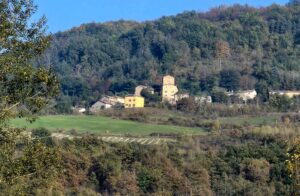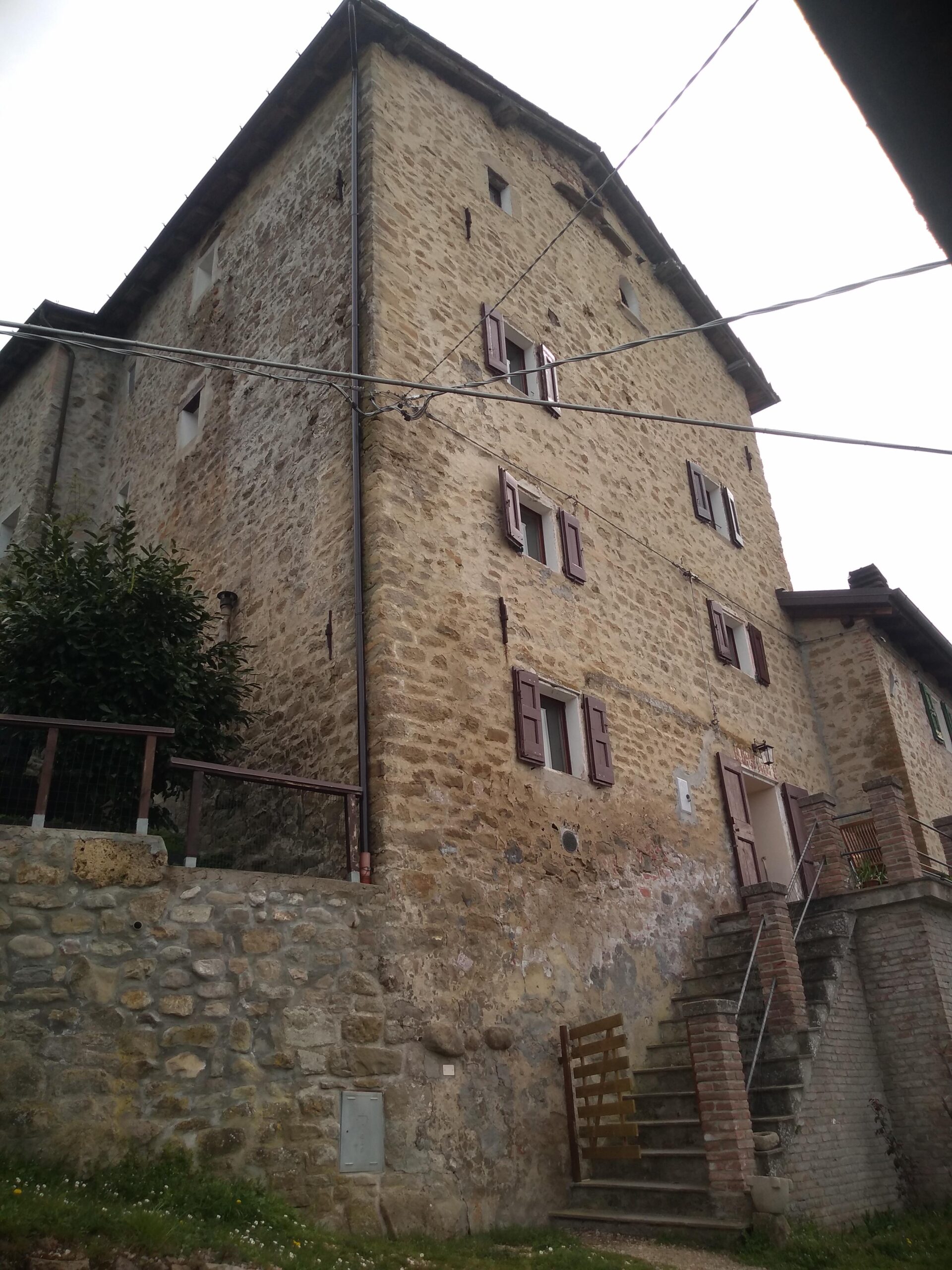
“Cerchate qualcuno? Are you looking for someone?”
We look up, startled. So the place isn’t completely deserted here after all. The woman leaning out of a window is smiling and waving with a kind of untethered enthusiasm. Two skinny arms stick out of an oversized T-shirt, despite the fact it’s barely two degrees outside. The cold doesn’t seem to bother her. When I ask if she knows which house is for sale she launches into a long and complicated explanation.
“Maybe Aldo’s house?” she says, pointing somewhere vaguely uphill. If we knew the area, her pointing might make sense. As it is, we’ve already gotten lost twice on the way here.
“I think we’re meant to go left here,” Dominique my partner in crime and wife indicates. I nervously eye the narrow lane next to the yellow house. The incline is steep, and the bend looks downright unreasonable.
“Maybe we should’ve taken that last turn,” I mutter, pulling the car slightly into the verge as a tractor with a trailer approaches from behind. The driver gives us a cheerful wave of thanks. “What does Maps say?”
It’s a Monday morning in late January, and we’re coming back from the weekly market in Vergato, the market town in the valley below us. The car still smells of the verdure fritte we bought for lunch—fried vegetables that, despite their modest appearance, proved impossible to resist. My fingers tingle from the cold. Outside, the clouds hang low and heavy, and there’s snow in the forecast.
“We could just come back another day. That tower isn’t going anywhere,” I suggest. She shakes her head and points at her phone.
“It’s supposed to be just up there,” she says. The yellow house blocks any view of what lies beyond. “And you’re the one who was so keen to see it.”
Our B&B, our current home is for sale, though we haven’t had any serious offers yet. That doesn’t stop us from spending our evenings scrolling through property websites like Immobiliare, Idealista, and Casa.it—the Italian equivalents of Rightmove. Unlike Rightmove though, these sites don’t give precise property locations. Instead, you have to call the agent, who will show you the place, which sounds charmingly old-school until you realize it’s absolutely necessary. Without them, you’d never find anything especially in the countryside.
We’ve become quite the veterans of the Italian property hunt—familiar with the adverts, the bidding process and, most importantly, its estate agents. Interior photos are usually a disaster: unmade beds, dirty dishes, six mattresses and a huge table squeezed into a room making it impossible to even estimate it’s size. The exterior shots, by contrast, will be breathtaking. But, naturally, they never show you the slaughterhouse, the power station, or the nightclub across the road. These details aren’t mentioned in the usually sketchy descriptions either. So, we’ve made it a rule to see properties and the surrounding area first before calling an agent.
Maps suggests that if we turn back, there’s another way up. Dutifully, I reverse and take the turn I missed earlier. A hundred meters later, we find a small cemetery. Three curious goats and a large white dog trot over to the fence to inspect us. Obviously, there’s a goat farm next to the graveyard—because why wouldn’t there be?
“I think we should’ve taken that first turn to the right,” she says, as though it’s perfectly normal for me to reverse the car yet again. After a few more twists and turns, we end up by a tiny church. A little further on is the fork that leads to Casigno. Not that we know it’s called Casigno yet. Even now, there’s exactly one sign pointing to the borgo, hidden in a tangle of brambles, and pointing in entirely the wrong direction.
Walking through the borgo feels slightly transgressive, like wandering through someone’s back garden uninvited.
A borgo is a cluster of houses. You could translate it as “hamlet,” but that would conjure the wrong image entirely. The word “borough” comes from the same root but who thinks of a borough as a medieval fortified group of houses forming a town with special duties and privileges anymore? Originally, in the murky depths of the Middle Ages, an Italian borgo was exactly that, a small collection of houses perched on higher ground, tightly packed together for defensive purposes. The fields and farmland would be spread out around it. By the 1950s, most of the inhabitants of these borgos abandoned them. Many houses are now only used in summer, if they haven’t been left to crumble altogether. This borgo, though, is beautiful—medieval, picturesque, and intact. A promising start.
We wander through, keeping an eye out for the vendesi sign that estate agents always slap on properties. Not this time, off course.
It’s my fault we’re here. I spotted this casa torre online—a traditional stone tower house that looks wonderfully imposing in the photos. It’s worlds apart from the chalet-style villas from the ’70s and ’80s mostly on offer. Never mind their questionable quality; they simply aren’t us. This house, though, is in sasso—stone—and apparently recently renovated.
The woman in the window—still there, impressively—doesn’t actually know if anything is for sale.
“Maybe that one. It used to be,” she says, gesturing toward the large yellow house we passed earlier. That definitely isn’t the one I’ve been studying the pictures of. “If anyone knows, it’s Annarita.” Unfortunately, Annarita won’t be home until late afternoon.
“Can we look around the borgo?” I ask. She doesn’t seem to understand, why we ask. Her name, we later learn, is Marya, she’s originally from Croatia and her Italian is a lot better than mine.
“It’s a borgo, people are always walking around here,” she says matter-of-factly. “Just don’t open any gates with dogs behind them.” And with that, she disappears inside.
The borgo is a maze of paths, steps, and levels. It isn’t large, but after three right turns, we’re completely disoriented.
“I think this actually might be it,” The house we’re standing next to is tall—very tall. Now we understand why it’s called a casa torre, a tower house.
She shrugs. “Could be. Where’s the garden, though?”
As we make our way back to the car, I let it all sink in.
“It’s a stunning borgo,” I say. She fully agrees, nodding empathically.
“But it isn’t what we’re looking for, is it?”
No, it absolutely is not what we were looking for.
